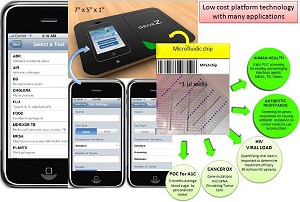MSU develops medical diagnostic tool, using solar and smart devices, for poorer nations
 Michigan State University (MSU) is developing Gene-Z, a medical diagnostic device, which is operated via an iPod Touch or Android-based tablet, and can be powered by the sun. The device is intended to allow physicians in countries with limited access to hospitals or clinical facilities to make certain diagnoses in the field. As such the device-makers are determining how to incorporate solar into the device.
Michigan State University (MSU) is developing Gene-Z, a medical diagnostic device, which is operated via an iPod Touch or Android-based tablet, and can be powered by the sun. The device is intended to allow physicians in countries with limited access to hospitals or clinical facilities to make certain diagnoses in the field. As such the device-makers are determining how to incorporate solar into the device.
The device performs genetic analyses on microRNAs and other genetic markers, according to MSU.
“MicroRNAs are single-stranded molecules that regulate genes; changes in certain microRNAs have been linked to cancer and other health-related issues,” the university said in a press release. Other issues the device could detect are routine tuberculosis and drug-resistant TB, HIV virus levels during treatment and to monitor overall antibiotic resistance.
"Gene-Z has the capability to screen for established markers of cancer at extremely low costs in the field," said Syed Hashsham, a professor of civil and environmental engineering at MSU. "Because it is a hand-held device operated by a battery and chargeable by solar energy, it is extremely useful in limited-resource settings.”
The device uses what’s called a microfluidic chip to assess a patient’s blood sample. In the device, the sample is heated, creating chemical reactions, which are processed by the device. Results are sent to the smart device for interpretation. Chips are mounted on credit card-sized devices, and different chips can detect different illnesses, according to PBS.
The complete device, including the iPod Touch or Android device, is slightly larger than a tablet computer, according to Hashsham.
“It’s a device itself that looks like an iPad,” he said.
Still, the battery needs to be larger than an iPad’s, so it can last longer, up to two days.
“It’s not very energy intensive, so the solar charger [doesn’t have to be too big],” he said.
The way the device will interact with a solar charger has yet to be determined, Hashsham said.
“[A] removable-charging panel will make sense,” he said.
It would be less prone to damage from the rain or other things that may damage an integrated charger.
“But the top surface and bottom surface of the device do not have anything on them. You could work [a small panel] into them,” he said.
Hashsham and his colleagues are still testing the device.
“There are still things like clinical evaluation and how it works in the field,” he said.
To keep the costs low, and therefore accessible, Hashsham is targeting a price lower than $1,000.
“It’s doing some of the powerful things, but not all,” he said.
The device is taking some of the low-end pathology tests and making them possible in the field.
Image courtesy of MSU.



